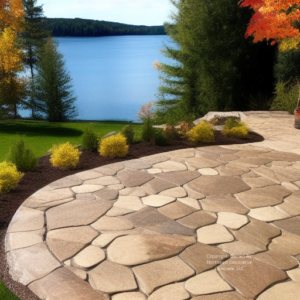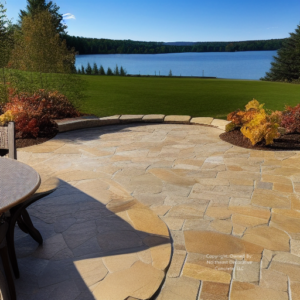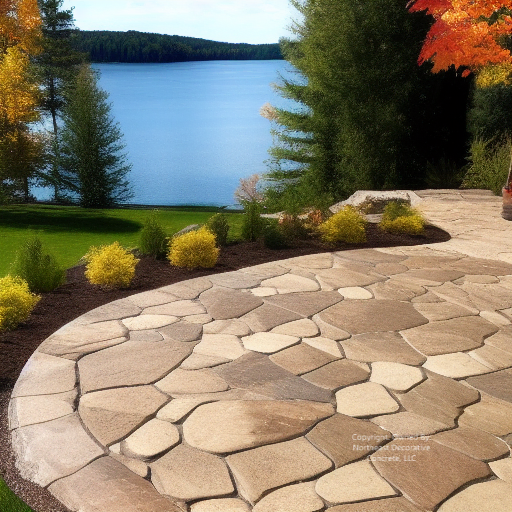
Are you considering stamped concrete for your outdoor space? Learn if stamped concrete cracks easily and what factors influence its durability.
Does Stamped Concrete Crack Easily?
The short answer is no. Stamped concrete does not crack easily. However, it is essential to note that all concrete can crack, whether stamped or plain. The best way to keep stamped concrete from cracking is to ensure it is properly installed with a high-quality concrete mix.
A proper concrete mix with a high cement content should be composed of 10-15% cementitious material, 60-75% aggregate, and 15-20% water. For instance, VDOT recommends a minimum cement content of 588 lbs. for Class A3 general mixes. Research has also determined that the type I cement range of 421 kg/m3 (710 lb./yd3) and a water-to-cement ratio of 0.30 can make high-performance concrete mixes. Additionally, Portland PFA cement, in combination with a superplasticizer admixture and a water content of 175 kg/m3, can be used for more potent concrete mixes.
Even though a patterned concrete slab can fail and chip like any other surface, it looks better than most. The pattern gives the illusion of hiding any imperfections, making the cracks less noticeable. Especially in climates with frost, this type of concrete is an attractive option, as it is more likely to hold up over time.
How Durable is Stamped Concrete When You Reseal?
Stamped concrete can bring a unique beauty to any outdoor space. But how durable is it? Well, it typically lasts up to 25 years—just as long as non-colored concrete. However, it can crack and fade with time, so resealing it every 3–5 years is wise. That way, you can enjoy the beauty of textured concrete for years to come!
Patterned concrete is known for being strong, and if it is installed and cared for properly, it can last for decades. The main factors affecting textured concrete’s durability are the materials’ quality and installation. Poor quality materials and improper installation can lead to failing and other damage.

Factors That Influence: The Durability of Stamped Concrete From Cracking
Several things can affect how long stamped concrete lasts, such as the quality of the materials, how it was installed, and the weather.
• Quality of the concrete mix
• Quality of the stamping job
• Quality of the sealer
• Frequency of cleaning and maintenance
• Exposure to harsh weather conditions
• Traffic (amount and type of traffic)
• Quality of the subbase preparation
• Quality of the reinforcement materials
• Type of release agent used
• Presence of deicing salts or other corrosive agents
Several elements determine the longevity of patterned concrete. These include how the concrete is mixed, how much water is mixed in, how much air is mixed in, how it is placed, how it is finished, and the weather conditions when it is laid. Additionally, the budget, environment, maintenance needs, and desired aesthetic should all be considered. Finally, a proper installation must be ensured to guarantee a lasting textured concrete surface.
Adding Quality Materials To Reduce The Concrete From Cracking
The quality of the materials used in the stamped concrete will affect its durability. High-quality materials will be more resistant to cracking and other damage.
Adding These Materials Will Make the Quality of The Concrete Stronger:
• Steel mesh
• Fiber mesh
• Polypropylene fibers
• Steel rebar reinforcing bars
• Polyvinyl chloride fibers
• Polyethylene fibers
• Expanded polystyrene beads
• Acrylic fibers
• Carbon fibers
• Polyurethane fibers
• Polyethylene fibers
The tensile strength of concrete is increased by steel rebar, so it can handle stretching, warping, and cracking. This reinforcement system allows pouring thinner concrete while maintaining its robustness. In addition, with rebar, concrete’s strength is broadened, making it capable of withstanding more force. Ultimately, rebar gives concrete the extra power to endure the most challenging conditions.
Stamped concrete is a good idea for floors that outperform many other materials in terms of resistance and durability. This is due to the materials’ quality; when top-notch components are employed, the result can be even more potent than standard concrete. However, it is not recommended for areas that require improved slip resistance. Patterned concrete patios are cost effective, can be a long-lasting and robust surface for many applications with proper maintenance.

Installation Process: To Properly Install Stamped Concrete Driveway
Stamped concrete must be properly installed to ensure its durability. Poorly installed textured concrete can be prone to failing and other damage.
The Steps Involved to Install Stamped Concrete Properly:
1. Clear and prepare the area for installation
2. Grade and compact the base
3. Install a moisture barrier
4. Install rebar or wire mesh for reinforcement
5. Pour the concrete and allow it to cure
6. Install control and expansion joints
7. Place the concrete stamps
8. Apply a release agent
9. Use a trowel to finish the concrete
10. Remove the stamps
11. Apply a curing compound
12. Apply sealer to protect the concrete
Installing patterned concrete requires careful preparation. Begin by pouring and aligning the stamps in the desired pattern. Next, test the concrete mix for viscosity and adjust it with water. Then, add the coloring and a release agent. Finally, press the stamps into the concrete for the desired texture and make sure the concrete is fully cured in cooler climates before washing off release. These steps are essential to ensure a successful and beautiful textured concrete installation.
How The Environment Can Impact The Concrete Patio Paver:
The environment in which the stamped concrete patio is installed can also affect its durability. Extreme temperatures, excessive moisture, and soil movement can all contribute to shifting and other damage.
Textured concrete can be a great addition to any environment but can be subject to damage from freezing and thawing. If plastic, lumber, or construction debris is left on the colored concrete during initial curing, it can cause uneven blotching. To prevent this, it is essential to use a color hardener when it is poured. In addition, the pattern may be less defined if the concrete is too soft or firm during stamping. Decorative concrete is an excellent choice for green design and healthy living as it is more sustainable than using new materials and creating a lot of waste.
FAQs
Q. Does Stamped Concrete Patios Require Maintenance?
A. Yes, patterned concrete requires some maintenance to ensure its durability. It should be sealed regularly with a slip resistance additive, and any open surfaces should be filled and repaired immediately. Clean your pool decks surface once a year with a pressure washer and cleaning agents.
Q. Is Stamped Concrete More Durable than Other Materials?
A. Textured concrete is known for its durability, but it is important to note that all concrete can crack, regardless of whether it is stamped or not.
Q. How Long Will Stamped Concrete Last?
A. Textured concrete patio can last for 25 years if properly installed and maintained. However, poor-quality materials and improper installation can lead to failing and other damage. Also, a decorative concrete patio will add value to your home if properly maintained, and could last longer than twenty-five years.
Q. What are The Disadvantages of Stamped Concrete?
A. It has the potential to fail if not properly installed, making it challenging to repair. In addition, DIY installation is not the easiest, and regular cleaning and resealing are required to keep its patterned look. These factors can be a downside. However, it can still be an excellent choice if you’re up for the challenge! You can get the look you’re after with proper preparation and maintenance.
Q. Is Stamped Concrete Easy to Crack?
A. Colored textured concrete is no different than any other variety of concrete concerning the possibility of cracking. However, proper installation and sealing can stand the test of time, providing decades of reliable use before any signs of failing or fading.
It is a practical choice for many, requiring only the proper maintenance and attention. Plus, it is built to last, ensuring you get the most out of your investment for an extended period.
Q. Does Stamped Concrete Crack More than Regular Concrete?
A. Decorative concrete has a better crack resistance than typical concrete but is still vulnerable to cracking. To minimize the chances of this, concrete contractors may need to regularly patch up a patio or walkway. However, avoiding this maintenance could lead to unsightly imperfect surfaces that can impact the look and feel of the space.
Decorative concrete is popular for outdoor spaces due to its versatility and low maintenance requirements. But the critical question is, does patterned concrete pavers crack quickly? The answer is no. Decorative concrete can fail slowly, if not installed correctly. However, it is essential to note that all concrete can crack, regardless of whether it is stamped or not. The key to preventing cracking is to ensure that the concrete patio paver is appropriately installed and maintained, using high-quality materials and considering the environment in which it has been installed.
Our Locations:
Nashua, NH
North Hampton, NH
Concord, NH

